|
|
 |
Fiche d'espèce de Copépode |
|
|
Calanoida ( Ordre ) |
|
|
|
Clausocalanoidea ( Superfamille ) |
|
|
|
Aetideidae ( Famille ) |
|
|
|
Gaetanus ( Genre ) |
|
|
| |
Gaetanus pungens (Giesbrecht, 1895) (F,M) | |
| | | | | | | Syn.: | Gaidius pungens Giesbrecht, 1895 c (p.249, Descr.F, figs.F); Giesbrecht & Schmeil, 1898 (p.32, Rem. F); Fowler, 1903 (p.125, Rem.); Esterly, 1905 (p.146, figs.F); Pearson, 1906 (p.12); Wolfenden, 1911 (p.223, Rem.); Esterly, 1916 (p.171, 180, nutrition); Campbell, 1929 (p.312, Rem.); Sewell, 1948 (p.348, 556); Davis, 1949 (p.27); Vervoort, 1949 (p.10, figs.F); 1952 d (n°45, p.3, figs.F); Brodsky, 1950 (1967) (p.163, figs.F); Vervoort, 1957 (p.58, Rem.: p.59, Rem.); Tanaka, 1957 (p.60, figs.M); Tanaka & Omori, 1970 (p.119, Descr.M, figs.M, Rem.); Morris, 1970 (p.2300, 2303, Descr.M, figs.M); Shih & al., 1971 (p.143); Park, 1978 (p.127, 130, Rem.); Dawson & Knatz, 1980 (p.5, figs.F); Bradford & Jillett, 1980 (p.61, figs.F, no M, vertical distribution, chart, Rem.); Gardner & Szabo, 1982 (p.220, figs.F,M); Guangshan & Honglin, 1984 (p.118, tab.); Rudyakov, 1986 (tab.1); Hernandez-Trujillo, 1989 a (tab.1); Hernandez-Trujillo, 1991 (1993) (tab.I); He & al., 1992 (p.250); Gowing & Wishner, 1992 (tab.1); Voronina & Kolosova, 1999 (p.71);
Ref. compl.: C.B. Wilson, 1950 (p.234); Ahlstrom & Thrailkill, 1963 (p.57, Table 5, abundance); Fleminger, 1967 a (tabl.1); Björnberg, 1973 (p.328, 386); Shih & Young, 1995 (p.67); Park & Choi, 1997 (Appendix); Hernandez-Trujillo, 1999 (p.284, tab.1); Lapernat, 2000 (tabl. 3, 4); Razouls & al., 2000 (p.343, tab. 5, Appendix); Haury & al., 2000 (p.69, Table 1); Rebstock, 2002 (p.71, Table 3, Fig.5, climatic variability); Lavaniegos & Jiménez-Pérez, 2006 (p.144, tab.2, 4, Rem.); Ikeda & al., 2006 (p.1791, Table 2);
Gaidius tenuispinus : Tanaka, 1957 a (p.60, Descr.M, figs.M, no F); ? Bradford, 1972 (p.38, figs.F);
no Gaidius pungens: Razouls & Durand, 1991 (p.75); | | | | Ref.: | | | Park, 1975 a (p.13); Markhaseva, 1996 (p.214, figs.F,M, Rem.); Lapernat, 2000 (tabl.3, 4); no Wolfenden, 1904 (p.131: Rem., fig.M); Vives & Shmeleva, 2007 (p.585, figs.F,M, Rem.) | 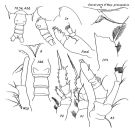 issued from : E.L. Markhaseva in Proc. Zool. Inst. RAN, St. Petersburg, 1996, 268. [p.216, Fig.171]. Female (from NE Indian). R: rostrum (anterior); P.md: mandibular palp; CP4: coxopod of P4. Nota: Posterior corners of last thoracic segment with spines exceeding the midlength of genital segment and covering about 3/5 of its length. Endopod of P2 1-segmented [2segments on figure), but 1-segmentd on the figure from Giesbrecht]
|
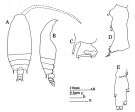 issued from : J.M. Bradford & J.B. Jillett in Mem. N.Z. Oceanogr. Inst., 86, 1980. [p.62, Fig.41, A-E]. As Gaidius pungens. Female: A, habitus (dorsal, B, idem (lateral right side); C, genital segment (lateral right side); D, basipod 1 of Mxp; E, endopod of P2. Nota: Endopod of P2 is one-jointed althrough the fusion line is obvious, especially on the posterior surface.
|
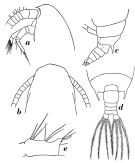 Issued from : W. Vervoort in Zool. Verh., Leiden, 1949, 5. [p. 11, Fig.4]. As Gaidius pungens. Female (from Arafura Sea): a, forehead (lateral); b, idem (dorsal); c, last thoracic segments and urosome (lateral left side); d, idem (dorsal); e, 1st basal segment of Mxp. Nota: The proportional lengths of the cephalothorax and urosome 42:10. The abdominal segments and furca in the proportional lengths 34:17:15:15:10 = 100. A1 (24-free segments) reaches the end of the cephalothorax. The 1st basal segment of Mxp shows no trace of a lamella.
|
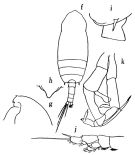 issued from : O. Tanaka in Publ. Seto Mar. Biol. Lab., 1957, VI (1). [p.61, Fig.37]. As Gaidius tenuispinus. Male (from Sagami, Japan): f, habitus (dorsal); g, forehead (lateral); h, rostrum (anterior aspect); i, last thoracic segment (lateral); j, P1: k, P5. Nota: Proportional lengths of urosomites and furca 19:30:19:19:2:11 = 100. Furcal rami about as long as wide. A1 (21-segmented) extends to distal margin of 2nd urosomal segment. A2: 1st basal segment has rows of hairs on posterior surface, and a strong inner marginal seta. mx1: outer lobe with 7 setae, exopod with 11 setae, endopod with 9 setae.
|
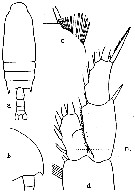 issued from : C.O. Esterly in Univ. Calif. Publs Zool., 1905, 2 (4). [p.146, Fig.15]. As Gaidius pungens. Female (from San Diego Region): a, habitus (dorsal); b, forehead (lateral); c, tube-like processes on inner distal portion of 2nd basipodite of P4; d, P1 (ri : endopod).
|
 issued from : W. Giesbrecht in Bull. Mus. comp. Zool. Harv., 25 (12). [Taf. I, Figs.1-4]. As Gaïdius pungens. Female (from 35°N, 125°W): 1, P2; 2, urosome (ventral); 3, P1; 4, forehead (lateral).
|
 issued from : B. Morris in J. Fish. Res. Bd Canada, 1970, 27 (12). [p.2303, Fig.2]. As Gaidius pungens. Male (from NW Gulf of Alaska): A, forehead (lateral); B, posterior prosome and 1st urosomal segment (right side); C, P1 (posterior); D, P5 (posterior); E, exopodite segment 3 of left P5 (posterior); F, endopodal segment of left P5. Nota : Terminal spines acutely pointed of the thoracic segment 5 slightly shorter than in the female, extending to the distal margin of the urosomal segment 1. Rostrum short, wider than long, an its blunt apex minnutely notched. Exopod of P1 2-segmented, endopod 1-segmented. Exopod of P2 3-segmented, endopod 1-segmented. P3 and P4 have both rami 3-segmented. P5 biramous and asymmetrical. The left exopod 3-segmented, the segments of proportional lengths 20 : 10 : 11. The inner distal edgeof the left exopodal segment 2 bears 2 slender spinules. The left exopodal segment 3 spiniform. The left endopod unisegmented, slender, and terminates in a small hooked point. The left endopod is 0.6 the length of the left exopodal segment 1. The right exopod with 2 equal segments. The right exopodal segment 2 curved, with 2 small internal swellings (a smaller one proximally and a larger one at about 2/3 the length of the segment ; this segment ends in a recurved point. The right endopod uniramus and club-shaped, it overreaches the distal edge of the basipodite 2 of the left P5.
|
 Gaetanus pungens female: 1 - Cephalon without frontal spine. 2 - Posterior corners of last thoracic segment with moderate spines. 3 - Exopodal segment 1 of A2 without setae; segment 2 with 2 setae. 2nd internal lobe of Mx1 with 4 setae. Exopod of P1 3-segmented with 2 external spines. 4 - Mxp protopodite without lateral plate. 5 - Md palp base with 1 seta.
|
 Gaetanus pungens Gaetanus pungens male: 1 - Cephalon without frontal spine. 2 - Cephalon without crest in anterior part. 3 - Exopodal segment 3 of left P5 stylet-like. Body size < 5 mm. 4 - Posterior corners of last thoracic segment with spines. 5 - Spines significantly shorter than the border of genital segment. 6 - Exopodal segment 3 of P5 with stylet-like narrow. 7 - Body size < 4 mm. 8 - Exopodal segment 2 of left P5 with uneven internal border with excavation near base of exopodal segment 3; exopodal segment 2 longer than exopodal segment 3.
| | | | | Ref. compl.: | | | Suarez-Morales & Gasca, 1998 a (p.108); Galbraith, 2009 (pers. comm.); in CalCOFI regional list (MDO, Nov. 2013; M. Ohman, comm. pers.) | | | | NZ: | 13 + 1 douteuse | | |
|
Carte de distribution de Gaetanus pungens par zones géographiques
|
| | | | | | | | | | | | 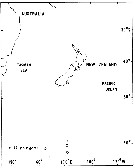 Issued from : J.M. Bradford & J.B. Jillett in New Zealand Ocean. Inst. Memoir, 86, 1980. [p.86, Figs.62]. Issued from : J.M. Bradford & J.B. Jillett in New Zealand Ocean. Inst. Memoir, 86, 1980. [p.86, Figs.62].
Distribution of Gaidius pungens ( = Gaetanus pungens) in the Tasman Sea and around New Zealand. |
| | | | Loc: | | | Antarct. (SE Pacif., Drake Passage), sub-Antarct. (Indian, Sw & SE Pacif.), W Sargasso Sea (in C.B. Wilson, 1950), off NW Cape Verde Is., N Ireland (in Pearson, 1906); E Indian, Indonesia-Malaysia, NE Marquesas Is., S Korea , China Seas (East China Sea, South China Sea), Japan (Izu), Aleutian Is., Pacif. (central subarctic), Strait of Georgia, Vancouver Is., San Diego, W California, BaJa California, off W Mexico, Pacif. (W equatorial), New Zealand, off Ecuador, off Peru, Chile (N & S, sub-Antarct.)
Type locality: 35°N, 125°W. | | | | N: | 55 ? | | | | Lg.: | | | (37) F: 3,2-2,65; M: 2,28; (39) M: 2,07; (41) F: 2,65; (47) F: 3,2; (59) F: 3,8-3; M: 2; (92) F: 3,4-3,21; M: 3,04; (113) M: 2,28-2,08; (142) F: 3,5-3; (201) F: 3,32-2,6; {F: 2,60-3,80; M: 2,00-3,04} | | | | Rem.: | bathypélagique.
Sampling depth (Antarct., sub-Antarct.) : 0-500 m.
Certains auteurs (Wolfenden, 1904, p.114; Bradford & Jillett, 1980, p.61) estiment qu'il existe une synonymie entre cette espèce et Gaidius tenuispinus (= Gaetanus tenuispinus) contrairement à Vervoort (1957), Park (1978) et Markhaseva (1996).
Voir aussi les remarques en anglais | | | Dernière mise à jour : 08/05/2016 | |
|
|
 Toute utilisation de ce site pour une publication sera mentionnée avec la référence suivante : Toute utilisation de ce site pour une publication sera mentionnée avec la référence suivante :
Razouls C., Desreumaux N., Kouwenberg J. et de Bovée F., 2005-2025. - Biodiversité des Copépodes planctoniques marins (morphologie, répartition géographique et données biologiques). Sorbonne Université, CNRS. Disponible sur http://copepodes.obs-banyuls.fr [Accédé le 05 janvier 2026] © copyright 2005-2025 Sorbonne Université, CNRS
|
|
 |
 |











